Week 3
⚠️ The deadline for this week’s submissions is Tuesday 9.4. at 23:59. You can do the tasks either by yourself or in the exercise sessions.
Return your work by pushing to the GitHub repository which you registered into Labtool. Remember to push your work before the deadline! Any work pushed after midnight will not be taken into account (or will bring 0 points).
The points and feedback will be available before next week’s deadline. Please check your points and feedback. If you get any questions or concerns about the grading, send a message through LabTool.
This week, you will get 1 points for returning the tasks and 2 points for returning the practical work.
Make a new folder named week3 under the exercises folder in your repository to submit this week’s exercises.
UML
We often use Universal Markup Language (UML) to draw the structure of our program. There are many different graph types available; today, we will get to know just three of them.
Class diagrams
If you have done the Introduction to Databases course, you may have seen how to use class diagrams. The point of class diagrams is to show the relationship between different classes in your program.
Suppose we have a Todo app that we want to draw a diagram for. The app has a class for its users:
class User:
def __init__(self, username, password):
self.username = username
self.password = password
and a class for its Todo items:
import uuid
class Todo:
def __init__(self, content, done=False, user=None, todo_id=None):
self.content = content
self.done = done
self.user = user
self.id = todo_id or str(uuid.uuid4())
def set_done(self):
self.done = True
If you’re wondering what the import uuid does, it lets you make random ID values, which the class uses to identify todo list tasks (instead of making the IDs 1, 2, 3, 4, …)
In this app, each todo has exactly one user attached, and each user can have multiple todo tasks. This is represented by the following diagram:
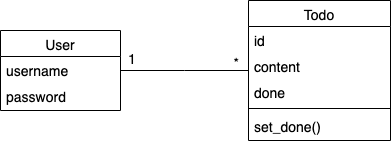
All of this information is a lot. Usually, we are only interested in the classes and their links between them, and we can simplify the diagram as follows:

You can see more details by reading the code (or “docstrings”, which we will get back to in week 6).
Dependency
The lines in UML-diagrams are fixed relationships between classes. Sometimes it is useful to also notate temporary relationships, or dependencies between classes.
We saw an example of fixed relationships above. An example of a temporary relationship is the following.
Below is the PaymentCard class from last week:
class PaymentCard:
def __init__(self, balance):
# balance is in cents
self.balance = balance
def add_money(self, amount):
self.balance += amount
def take_money(self, amount):
if self.balance < amount:
return False
self.balance = self.balance - amount
return True
As you can see, there is no mention of the cash register anywhere. The (redacted) code for the cash register is here:
CHEAP_PRICE = 2.5
YUMMY_PRICE = 4.3
class CashRegister:
def __init__(self):
self.cheap = 0
self.yummy = 0
def eat_cheap(self, card):
if card.balance() < CHEAP_PRICE:
return False
card.take_money(CHEAP_PRICE)
self.cheap += 1
return True
def eat_yummy(self, card):
# ...
def add_money_to_card(self, card, amount):
if amount < 0:
return
card.add_money(amount)
self.money += amount
The payment terminal class uses card (Kortti) objects temporarily when its eat food cheap/expensive and add money functions are called. However, it has no permanent memory of any payment cards. We draw such relationships as dashed lines instead of the solid lines in the previous part.
An example of a possible diagram is below. Note the dashed arrow, and the fact that we don’t label this arrow with a number (unlike the previous case.)

One final example. Here we have a class responsible for the program logic of our Todo app.
class TodoService:
def __init__(self, todo_repository, user_repository):
self._user = None
self._todo_repository = todo_repository
self._user_repository = user_repository
def create_todo(self, content):
todo = Todo(content=content, user=self._user)
return self._todo_repository.create(todo)
def get_undone_todos(self):
if not self._user:
return []
todos = self._todo_repository.find_by_username(self._user.username)
undone_todos = filter(lambda todo: not todo.done, todos)
return list(undone_todos)
# ...
The program logic knows and remembers the logged in user, but can only access the user’s todo list items only through the todo_repository object. This is why there is no fixed link, but only a dependency between the program logic and the Todo class.
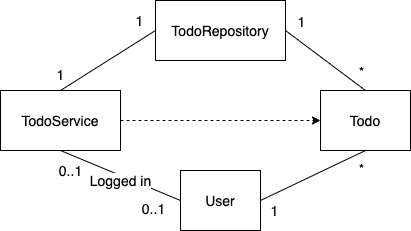
Marking down dependencies is not usually necessary; only do it if they tell you something insightful about the program logic.
Inheritance
Classes can inherit other classes (check the Advanced Course in Programming material!). To notate this in UML, we use arrows with white heads.
For example, if there was another class, SuperUser, that inherited the User class, it would be marked as follows:
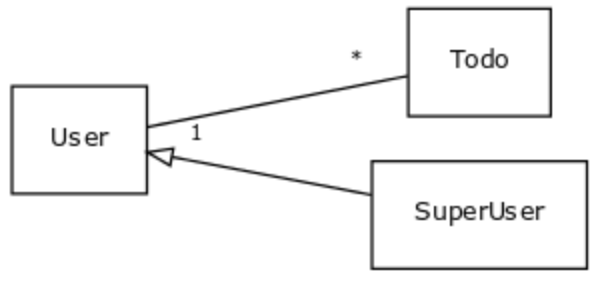
Tools to draw diagrams
When using Markdown on GitHub, you can draw these diagrams directly by typing out little bits of text instead of drawing pictures and saving them (!) To do this, we use something called Mermaid.
Here’s an example of how you would type this in Markdown:
## Program logic
The program relies on the User and Todo classes,
which are related in the following way:
```mermaid
classDiagram
Todo "*" --> "1" User
class User{
username
password
}
class Todo{
id
content
done
}
```
Note the three backticks (` symbols) that are used to tell Markdown that you have Mermaid code. You can also use these backticks to e.g. show Python code in your Markdown files. The code will not be run but will appear nicely formatted in your text.
When rendered, the diagram looks like this:
classDiagram
Todo "*" --> "1" User
class User{
username
password
}
class Todo{
id
content
done
}
Of course, you’re allowed to use any program you like for drawing diagrams (Paint, PowerPoint, etc.) but Mermaid is the recommended way.
Task 1: Monopoly
Let’s take a toy example: the game Monopoly. We will make a class diagram representing the relationship between the different things in the game.
First step: basics. Our game has at least 2 and at most 8 players. There are 2 dice. There is 1 game board. The board has 40 squares. Each square knows what the next square is. Each player has one piece that they play with. Each piece is in exactly one square.
classDiagram
MonopolyGame "1" -- "2" Dice
MonopolyGame "1" -- "1" Board
Board "1" -- "40" Square
Square "1" -- "1" Square : next
Square "1" -- "0..8" Piece
Piece "1" -- "1" Player
Player "2..8" -- "1" MonopolyGame
The above diagram is made with the following code:
```mermaid
classDiagram
MonopolyGame "1" -- "2" Dice
MonopolyGame "1" -- "1" Board
Board "1" -- "40" Square
Square "1" -- "1" Square : next
Square "1" -- "0..8" Piece
Piece "1" -- "1" Player
Player "2..8" -- "1" MonopolyGame
```
Your task is to extend this diagram. Make the following amendments:
- There are multiple different types of squares
- Starting square
- Jail
- Chance and Community Chest
- Train stations
- Utilities
- Normal streets that have a name
- The MonopolyGame class needs to know where the starting square and the jail square are
- Each square has some sort of functionality (which can be just some function, pick any name)
- Chance and Community Chest squares each have some cards, which have some functionality (again, just some function)
- There are different types of functionalities. No need to specify what kind.
- The players have money
- The streets can have at most 4 buildings or one hotel
- The streets can be owned by some player
If you don’t know how to use Mermaid, you can check the syntax from their webpage.
Create a folder called week3 under the exercises folder and add your diagram there.
If you use Mermaid to make your diagram, you can just add a Markdown file with your Mermaid code inside.
Package diagram
The code of the Todo app is laid out as follows in different files and folders. Note: in this section we call folders packages.
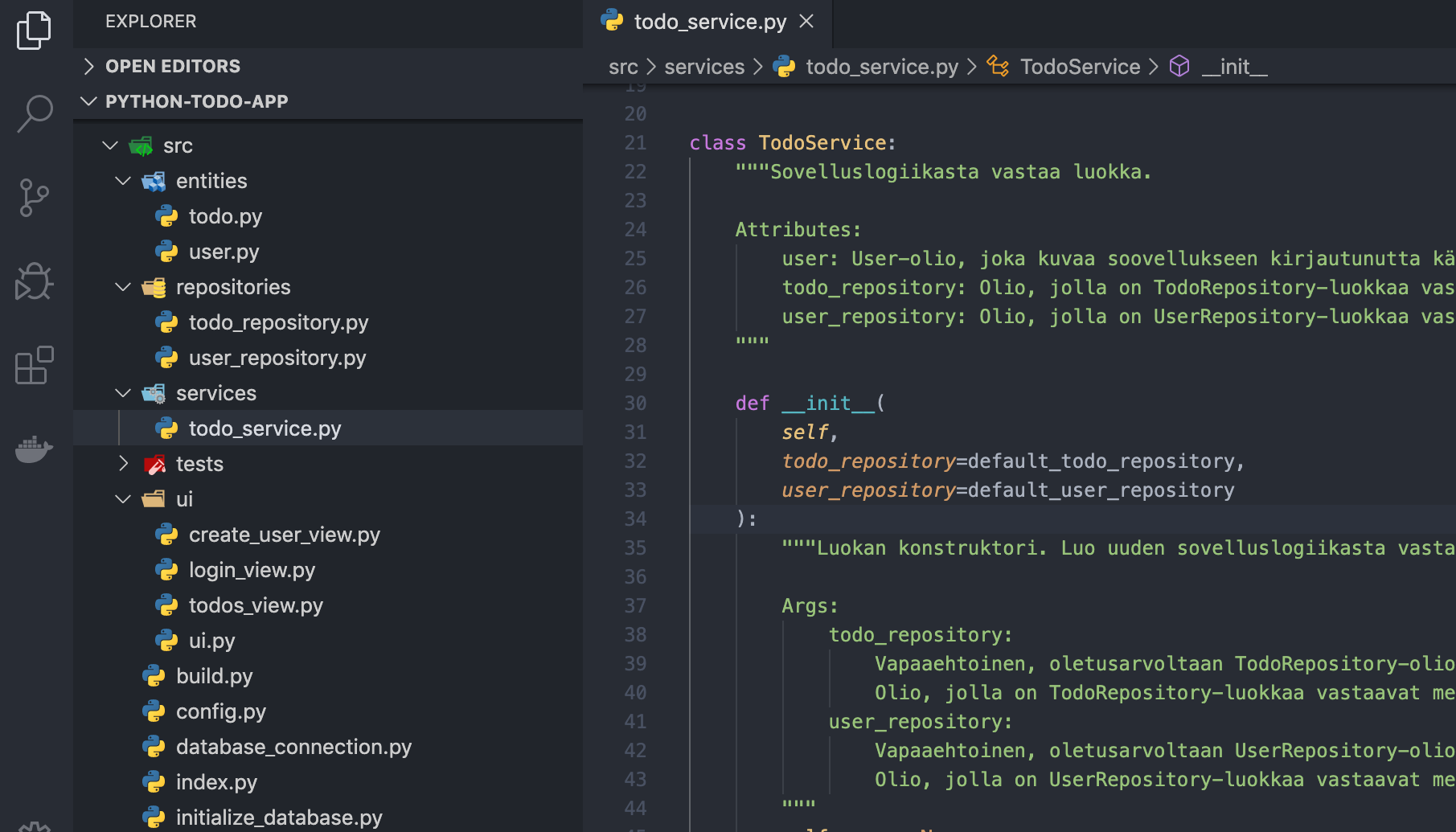
We can visualise this by using a package diagram in Mermaid.

Dependencies between the packages (folders) are denoted by a dashed line.
The ui package depends on the services package, since the classes in the files inside the ui folder depend on the classes in the files in the services folder. More specifically, they depend on the TodoService class, which is in the todo_service.py file in the services folder.
Similarly, the services package depends on the repositories package, since the TodoService class (somewhere in the services folder) uses the TodoRepository and UserRepository classes (somewhere in the repositories folder).
Instead of writing this out in words, we could also have displayed this information as a diagram, showing what classes can be found in which folders:
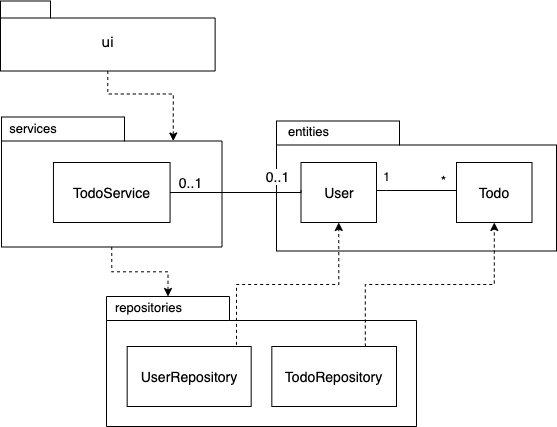
Remember, if you need a recap on how these sorts of programs (with classes doing certain things) work, check out part 10 of the Advanced Programming course, under “Developing a larger application”. To see how to apply this to your own project, check out the implementation guidelines.
Sequence diagrams
The previous two types of diagrams, class and package diagrams, describe the program’s structure. However, the functionality of the application is not encoded in any way. Sequence diagrams aim to describe how classes call each others’ functions.
Let’s go back to the payment card and payment terminal example.
Paying by card works as follows: the payment terminal checks whether the balance on the card is enough, and if it is, it then takes money off the card by calling the take_money method.
CHEAP_PRICE = 2.5
class CashRegister:
# ...
def eat_cheap(self, card):
if card.balance() < CHEAP_PRICE:
return False
card.take_money(CHEAP_PRICE)
self.cheap += 1
return True
# ...
This can be represented by a class diagram (not yet a sequence diagram!) as follows:

Now, this doesn’t describe the functionality at all. The above interaction can be represented by a sequence diagram like this:
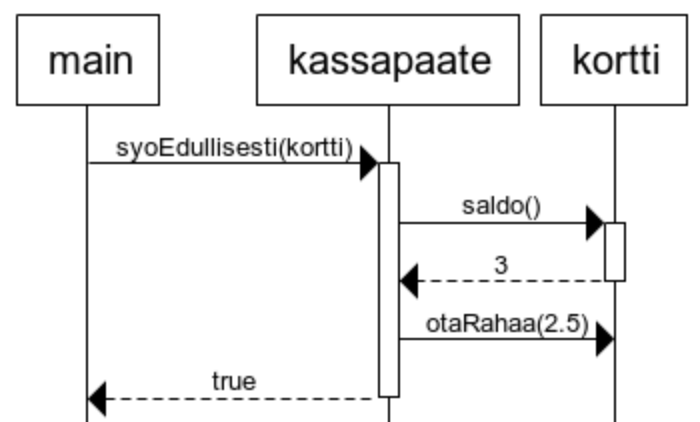
On sequence diagrams, time goes from top to bottom. Function calls are represented by horizontal arrows going from whoevers calling a function, to the class whose function is being called. A return value is represented by a dashed line. Reading a parameter is represented in the same way as a function call.
Let’s see another example. In this case, the sequence diagram shows what happens if the card doesn’t have enough money on it.
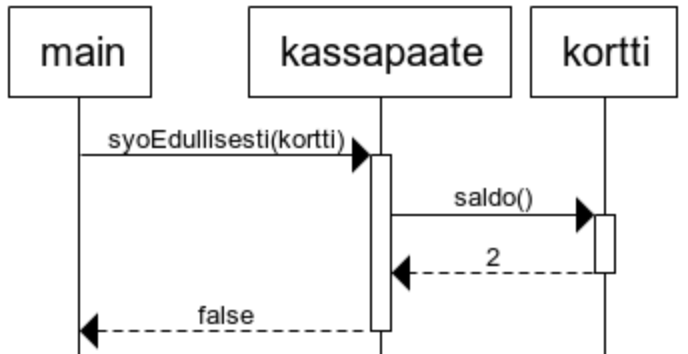
More complex example
Have a look at this more complex example. Note that, although it’s in Finnish, you don’t need to understand what the Finnish words mean. You can imagine that they’re complete gibberish. Just imagine you are the computer reading the code, and stepping through it one line at a time, going into functions whenever you come across them.
Try to compare the code (stepping through it one line at a time) to the sequence diagram, and see if it makes any sense that way.
Code:
class Henkilo:
def __init__(self, nimi, palkka, tilinumero):
self.nimi = nimi
self.palkka = palkka
self.tilinumero = tilinumero
class Henkilostorekisteri:
def __init__(self):
self._henkilot = {}
self._pankki = PankkiRajapinta()
def lisaa(self, henkilo):
self._henkilot[henkilo.nimi] = henkilo
def suorita_palkanmaksu(self):
for nimi in self._henkilot:
henkilo = self._henkilot[nimi]
self._pankki.maksa_palkka(henkilo.tilinumero, henkilo.palkka)
def aseta_palkka(self, nimi, uusi_palkka):
henkilo = self._henkilot[nimi]
henkilo.palkka = uusi_palkka
class PankkiRajapinta:
# ...
def maksa_palkka(tilinumero, summa):
# suorittaa maksun verkkopankin internet-rajapinnan avulla
# yksityiskohdat piilotettu
Main function:
def main():
rekisteri = Henkilostorekisteri()
arto = Henkilo("Hellas", 1200, "1234-12345")
rekisteri.lisaa(arto)
sasu = Henkilo("Tarkoma", 6500, "4455-123123")
rekisteri.lisaa(sasu)
rekisteri.aseta_palkka("Hellas", 3500)
rekisteri.suorita_palkanmaksu()
Sequence diagram:
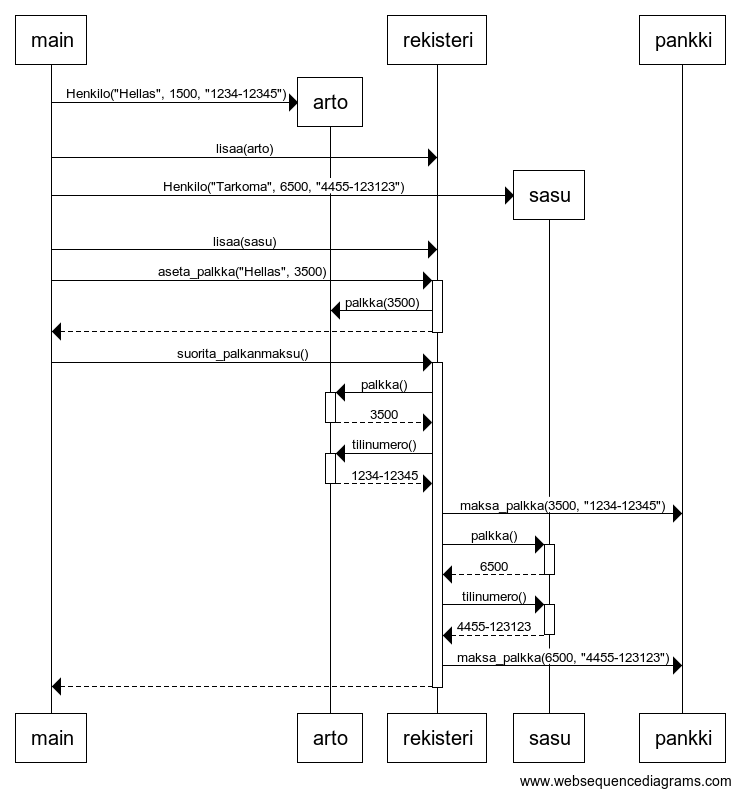
Try to spend at least 5-10 minutes figuring out what this sequence diagram is saying. This is a rather complex example, and fully understanding what is going on (especially if you do not speak Finnish) is not required. We will practice drawing our own sequence diagrams soon.
Tools for drawing sequence diagrams
You can use Mermaid again! For this, check the instructions on their website: Sequence diagram.
You can also check the example project’s sequence diagram here: architecture
Task 2: sequence diagram
Let’s take another short program, that simulates how HSL cards work.
Your task is to describe how the main function works as a sequence diagram.
Your sequence diagram must include (similar to the above example):
- All object creation
- All function calls
- All variable reads (if they happen across different classes)
Code:
class Kiosk:
def buy_travel_card(self, name, amount = None):
new_card = TravelCard(name)
if amount:
new_card.increase_balance(amount)
return new_card
class TravelCard:
def __init__(self, owner):
self.owner = owner
self.day = 0
self.month = 0
self.amount = 0
def increase_balance(self, amount):
self.amount += amount
def reduce_balance(self, amount):
self.amount -= amount
def new_time(self, day, month):
self.day = day
self.month = month
class TicketBooth:
def add_balance(self, card, amount):
card.increase_balance(amount)
def add_time(self, card, day, month):
card.new_time(day, month)
TRAM = 1.5
HELSINKI = 2.1
CAPITAL_REGION = 3.5
class Reader:
def buy_ticket(self, card, ticket_type):
price = 0
if ticket_type == 0:
price = TRAM
elif ticket_type == 1:
price = HELSINKI
else:
price = CAPITAL_REGION
if card.amount < price:
return False
card.reduce_balance(price)
return True
class HSLCardReaderManagement:
def __init__(self):
self._ticketbooths = []
self._readers = []
def add_ticketbooth(self, ticketbooth):
self._ticketbooths.append(ticketbooth)
def add_reader(self, reader):
self._readers.append(reader)
def main():
management = HSLCardReaderManagement()
rautatietori = TicketBooth()
tram6 = Reader()
bus244 = Reader()
management.add_ticketbooth(rautatietori)
management.add_reader(tram6)
management.add_reader(bus244)
kiosk1 = Kiosk()
kalles_card = kiosk1.buy_travel_card("Kalle")
rautatietori.add_balance(kalles_card, 3)
tram6.buy_ticket(kalles_card, 0)
bus244.buy_ticket(kalles_card, 2)
if __name__ == "__main__":
main()
Add your diagram to the laskarit/viikko3 folder.
If you use Mermaid to make your diagram, you can just put the Markdown file with the Mermaid code in your folder.
Invoke and making tasks
Imagine you have the following situation: you’ve written your app and you run it. While it’s running, it creates lots of different files and saves stuff and makes a mess. You then want to run it again from a clean slate.
This is very annoying and tedious to do by hand. Thankfully, we can create a task that will do everything for us. An example of a task can be: delete all unnecessary files and start your program’s main file by running the command python3 src/index.py.
To make tasks, we will use a tool called Invoke.
Installation
In your project folder, run
poetry add invoke
Making tasks
Tasks are added to the root of your project into a file called tasks.py. Here, as a toy example, we create a task foo that just prints the word bar. Note that the @task text before the function is called a decorator and tells Invoke that the function we’ve written is a task.
from invoke import task
@task
def foo(ctx):
print("bar")
We can run this by typing the following in a terminal:
poetry run invoke foo
For an actual useful example, let’s make a task that starts our program:
from invoke import task
@task
def foo(ctx):
print("bar")
@task
def start(ctx):
ctx.run("python3 src/index.py", pty=True)
You can test this by running poetry run invoke start. Note that, in the above code, you need to include pty=True for everything to work.
You can list all the available tasks by running
poetry run invoke --list
Naming tasks
Don’t use camelCase to name your tasks. Instead, use snake_case. Note that in this case, when running the command in the terminal, the command will be in kebab-case.
Example:
from invoke import task
@task
def lorem_ipsum(ctx):
print("Lorem ipsum")
You run this using poetry run invoke lorem-ipsum.
Dependent tasks
Another use case of tasks: making coverage reports.
Last week, we used two commands, coverage run --branch -m pytest and coverage html (in that order) to first test the program and then generate the coverage report.
We could create two new tasks like this:
from invoke import task
@task
def coverage(ctx):
ctx.run("coverage run --branch -m pytest", pty=True)
@task()
def coverage_report(ctx):
ctx.run("coverage html", pty=True)
And then run the tasks in order like this:
poetry run invoke coverage coverage-report
If you run the tasks in the wrong order, you’ll either get old results or an error. To avoid doing this by accident, let’s tell Invoke that the coverage_report function is dependent on the coverage function:
from invoke import task
@task
def coverage(ctx):
ctx.run("coverage run --branch -m pytest", pty=True)
@task(coverage)
def coverage_report(ctx):
ctx.run("coverage html", pty=True)
Now, running poetry run invoke coverage-report will automatically first run the coverage task and you don’t have to worry about running both in a specific order.
Practical work
This week, you will begin implementing your program and testing it. Your project should progress more-or-less evenly throughout all the weeks of the course. That is, if you get all of your work done before the end of the course, then you will still need to do a comparable amount of work each week (by extending your program, etc.) to get progression points.
This week, you will get 2 points for returning the practical work. You may check the grading requirements to see what’s expected of you.
Warning: pip
If you install packages, don’t do it through pip. Use Poetry to install all packages.
Practical work 1: Initialising your project and using Poetry
Use last week’s Poetry instructions to initialise your project. Your main repository’s folder structure should looks something like this:
exercises/
...
documentation/
...
src/
...
pyproject.toml
poetry.lock
README.md
...
The exercises folder contains all your weekly exercises; nothing related to the practical work.
documentatoin should contain the documentation you will be writing (and have already started writing).
Finally, the src folder will contain all your source code for the practical work.
Note: under every folder that’s inside the src folder (and in the folders inside those, and in the folders inside those…) you should create an empty file with the name __init__.py. This will ensure that all imports work as intended. Do not put an __init__.py file in the src folder itself.
Practical work 2: Functionality
Make some functionality for your program, based on your last week’s spec document.
The functionality should be put into classes (except if it’s stuff related to graphics or a user interface).
Just empty classes or functions won’t give you points. As an example, if you said last week that your program will calculate something, implement (part of, or all of) the calculation in a class.
Some more instructions on implementing can be found here. If you are making a game, check out the pygame instructions.
Practical work 3: Preliminary test implementation
Your app should have at least one test. The test should test something that’s relevant to the functionality of your program. It must also pass.
Make a new folder for your tests under src:
src/
tests/
__init__.py
...
...
Review last week’s unittest instructions and make a test for one of the classes you implemented in the previous part.
Practical work 4: Test coverage report
In the same folder as your pyproject.toml file (i.e. in the root of your repository) there should be a .coveragerc file (create it if not).
Paste the following code into there:
[run]
source = src
omit = src/**/__init__.py,src/tests/**
Review last week’s material to make a coverage report for your implemented features.
Practical work 5: Invoke tasks
Make the following invoke tasks (using the previous section’s instructions):
poetry run invoke startruns your programpoetry run invoke testruns your tests using pytestpoetry run invoke coverage-reportcollects the test coverage data and generates an HTML file that contains the coverage report (same as the example in the previous section).
The reference project should have an example on this. You can also add other tasks if you find that they save you some time or some hassle.
Practical work 6: Changelog
One common way of tracking your progress is using a changelog.
In the documentation folder, make a changelog.md file and add the changes that you make to your project every week. Examples of significant changes that you should include:
- Changes to the user interface
- New features
- Architectural changes (new classes, functions)
- New tests
An example of a changelog for this week:
## Week 3
- The user can now see a list of all todos
- Added a `TodoRepository` class, which is responsible for saving the todos into a CSV file
- Added a `TodoService` class, which handles the program logic
- Added tests to verify that the `TodoRepository` class returns all the todos
Add a link to the README.md file that leads to the changelog.md file.
Practical work 7: Other stuff
Make sure that the following things are in order:
- Time tracking sheet is up-to-date
- Do not include the time spent on the weekly exercises
- You’ve updated the
changelog.mdfile - Your
README.mdfile is clean and professional- The file should contain only information that’s relevant to your project
- The title should be your project name
- There should be a short description of your project
- All the links to your documentation should be in a neat list under the title
Documentation - All other links (e.g. links to the
exercisesfolder and its files) should be deleted - See the example for details
- The repository is clean
- You should not have any
pytestorcoveragerelated files in your repository - If there are, remove them by running
git rm - Make sure that these files are then ignored using a
.gitignorefile - Also, include any other trash files you may have in your
.gitignore - Any files related to the weekly exercises should be under
exercises
- You should not have any
Make sure the project works as intended
NOTE: In order to receive weekly points for the assignment, the application must work on the university’s computer and the TAs must be able to run your code on them! You can test this on any Cubbli computer, such as the freshers’ laptop, or on the computers in your institution’s computer classes. You can also test on a virtual workstation using either a browser or the VMWare Horizon client.
In the virtual workstation, testing of your own application can be done using the browser as follows:
- Log into virtual workstation and select Cubbli Linux
- Start the terminal and check the version of Python in use with the command
python3 --version. If the version is below 3.8, update the version using the instructions here - Make sure that Poetry is installed by running
poetry --version. If the installation is missing, follow these Linux installation instructions - Clone your repository to the directory of your choice using the
git clonecommand - Go to your project’s directory and install the dependencies using the
poetry installcommand. Note that the command must be run in the directory where thepyproject.tomlfile is located.
If the connection to the virtual workstation fails, you should try another browser. Users have reported that at least Google Chrome works quite well. Installing VMWare Horizon Client may also help.
Note: If you are running an application which uses an SQLite database on a virtual desktop, you may encounter the error database is locked. You can probably fix the issue by following these instructions.
Do not plagiarise or break copyright law
Plagiarism
The course follows the University of Helsinki’s study policies Plagiarism and academic plagiarism, i.e. copying answers from the internet or from a friend and returning them as your own work is forbidden. A proven case of plagiarism will result in the failure of the course and repeated cases of plagiarism may result in the suspension of the right to study.
What does plagiarism mean in the context of the practical work? Direct copying of code is prohibited, with the exception of short snippets of code and code generated by ChatGPT or similar tools (see below). Direct copying of code structure, e.g. by changing the names of variables and functions, also counts as plagiarism. On the other hand, you may use images found on the web if you have the right to do so (see below), but if you do so, you must include a reference to it in the documentation of the work, i.e. mention where the quotation was made.
The same plagiarism rules apply to the documentation of the work and it is particularly forbidden to copy-paste the documentation of a reference project.
ChatGPT and similar
Representing code or text generated by ChatGPT and similar AI-based tools (such as Bing Chat, Google Bard or GitHub Copilot) as self-plagiarism is also plagiarism. The use of generated code is allowed in the course, but always “surround” such code with the comments # AI-generated code begins and # AI-generated code ends. Do this even if you have made minor changes to the generated code (changing the names of variables and functions, etc.).
Remember that the use of ChatGPT and similar tools for generating tests is prohibited in the course.
Copyright
Please respect copyright and other intellectual property rights. Remember that you may not use anything found online for your own work. This applies to a wide range of material from software code to images and texts. So always check whether use is permitted under the licence under which the material may have been distributed. Remember that your work is public by default on GitHub. It is your own responsibility not to infringe copyright.
✍️ Löysitkö kirjoitusvirheen? Tee korjausehdotus muokkaamalla tätä tiedostoa GitHubissa.